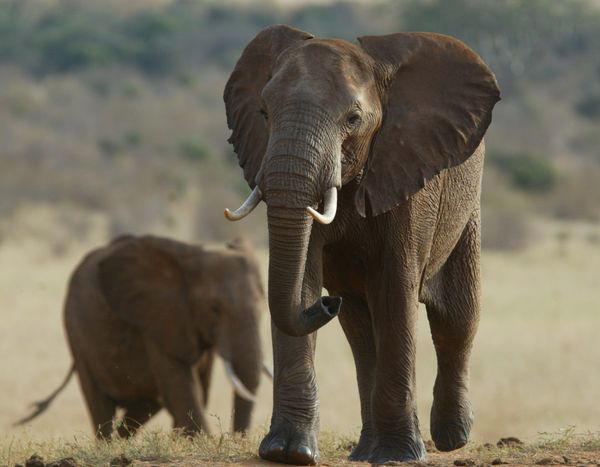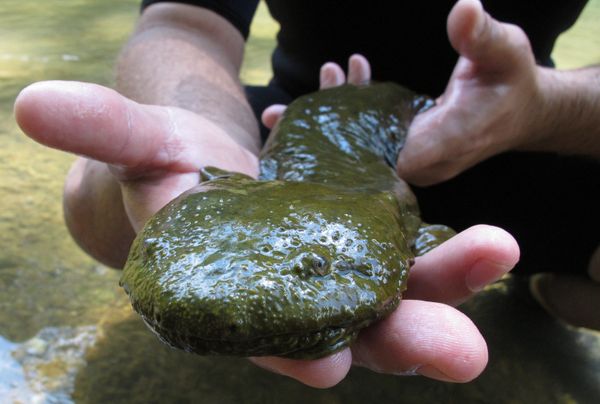The global wildlife population is expected to drop 67% by 2020.
Nature is facing a global "mass extinction" for the first time since the demise of the dinosaurs as global wildlife populations are expected to drop by more than two thirds by the end of the decade.
A landmark report of 14,152 populations of 3,706 species of mammals, birds, fish, amphibians and reptiles from around the world reveals a 58% fall between 1970 and 2012 - with no sign the average 2% drop in numbers each year will slow.
By 2020, populations of vertebrate species could have fallen by 67% over a 50-year period unless action is taken to reverse the damaging impacts of human activity, the Living Planet Index from WWF and the Zoological Society of London (ZSL) said.
African elephants, orcas, tigers, mountain gorillas, amphibians and leatherback turtles are just some of the species most under threat of extinction.
African elephants in Tanzania have seen numbers crash due to poaching, maned wolves in Brazil are threatened by grasslands being turned into farmland and European eels have declined due to disease, over-fishing and changes to their river habitats.
Species are being increasingly affected by unsustainable agriculture and fishing, as well as mining and other human activities that cause habitats to be lost or become degraded.
Wildlife is also being hit by over-exploitation, climate change and pollution, the report warned.
 |
| Africa's elephant population has crashed by an estimated 111,000 in the past decade primarily due to poaching. 2016 estimates suggest there are 415,000 elephants across the 37 range states in Africa. Karel Prinsloo/AP |
 |
| The maned wolf, along with other large mammals including the giant anteater, is threatened by the increasing conversion of grasslands into farmland for grazing and growing crops in the Brazilian Cerrado. Auscape via Getty Images |
 |
| The hellbender salamander underwent population declines of 77 per cent across five locations in Missouri between 1975 and 1995. Degradation of habitat from the effects of agriculture and the recreational use of rivers is believed to be the main cause of the decline. Rick Callahan/AP |
 |
| Orca populations in European waters are under threat from persistent organic pollutants (POPs). Despite legislative restrictions on their use, these pollutants are still present in orcas' blubber at levels that exceed all known marine mammal toxicity thresholds. ASSOCIATED PRESS |
 |
| The leatherback turtle has become increasingly rare in both the tropical Atlantic and Pacific. For example, it declined by 95 per cent between 1989 and 2002 in Las Baulas National Park in Costa Rica. This decline was caused mainly by mortality at sea due to individuals being caught as by-catch and by development around nesting beaches. Similar trends have been observed throughout the species range. David McFadden/AP |
 |
| The European eel is declining due to disease, overfishing and changes to its freshwater habitat that impede its migration to the sea to breed. Yannis Behrakis / Reuters |
 |
| The White-backed vulture, long-billed vulture, slender-billed vulture and the Himalayan griffon (pictured) have been decimated throughout South East Asia over the past 20 years due to the widespread use of the anti-inflammatory cattle drug diclofenac. The drug causes kidney failure in birds that eat the carcasses of recently-treated cattle. AP PhotoWichai Taprieu |
 |
| The Yangtze river dolphin has declined largely due to incidental mortality by collisions with fishing vessels and entanglement in fishing gear An intensive survey carried out in China in 2006 failed to find any evidence that the species survives. Stephen Leatherwood/PA Archive |
 |
| India and Nepal: degradation of its habitat, accidental bycatch in fishing nets and harvesting of eggs have led to declines of this critically endangered species of crocodile. PRAKASH MATHEMA via Getty Images |
 |
| A species of fungus that causes chytridiomycosis, a disease of amphibians, is implicated in the steep decline or extinction of more than 200 species. ASSOCIATED PRESS |
 |
| Major Mitchell's cockatoo underwent a precipitous population crash in Australia, largely due to the illegal taking of eggs for the pet trade. The population is now slowly recovering due to better enforcement of the law, but the species remains at risk from the clearing of woodland habitat and the destruction of nesting trees. slpu9945 via Getty Images |
 |
| About 3,900 tigers are left in the wild facing threats of habitat destruction, climate change, and human wildlife conflict. The species is critically endangered. Ratnakorn Piyasirisorost via Getty Images |
 |
| As few as 70 Amur leopards are left in the wild, facing threats of habitat destruction and human wildlife conflict. The species is critically endangered. ASSOCIATED PRESS |
 |
| 1,864 giant pandas remain in the wild. Threats include human wildlife conflict and climate change. The species is listed as vulnerable. ASSOCIATED PRESS |
 |
| 880 of the critically endangered mountain gorilla remain in the wild facing threats of habitat destruction and human wildlife conflict. Ben Curtis/AP |
While wildlife continues to decline on average, species that depend on certain habitats have seen some improvements in recent years, the report revealed.
Grassland species have increased slightly since 2004, which the report puts down to conservation efforts for some mammals in Africa, though bird populations continued to decline.
Overall terrestrial species, which are found in habitats ranging from grasslands to forests, have seen populations drop by two-fifths (38%) since 1970.
Freshwater species are faring even worse, with declines of four-fifths (81%) between 1970 and 2012.
Wetland wildlife has seen an increase since 2005, and marine species have been stable since 1988 - although the majority of stocks that contribute most to global fish catches are now either fully fished or overfished, the report warned.
Mike Barrett, director of science and policy at WWF-UK, said: "For the first time since the demise of the dinosaurs 65 million years ago, we face a global mass extinction of wildlife.
"We ignore the decline of other species at our peril – for they are the barometer that reveals our impact on the world that sustains us.
"Humanity's misuse of natural resources is threatening habitats, pushing irreplaceable species to the brink and threatening the stability of our climate."
But he added: "We know how to stop this. It requires governments, businesses and citizens to rethink how we produce, consume, measure success and value the natural environment.
"In the UK, this demands a serious plan to strengthen protection for habitats and species and new measures to fast-track low-carbon growth."
Professor Ken Norris, director of science at ZSL said: "Human behaviour continues to drive the decline of wildlife populations globally, with particular impact on freshwater habitats.
"Importantly, however, these are declines – they are not yet extinctions – and this should be a wake-up call to marshal efforts to promote the recovery of these populations."
The report highlights the success of habitat protection and strict controls on hunting in Europe to help restore populations of wildlife including bears, lynx, wolverines and wolves.
Links


